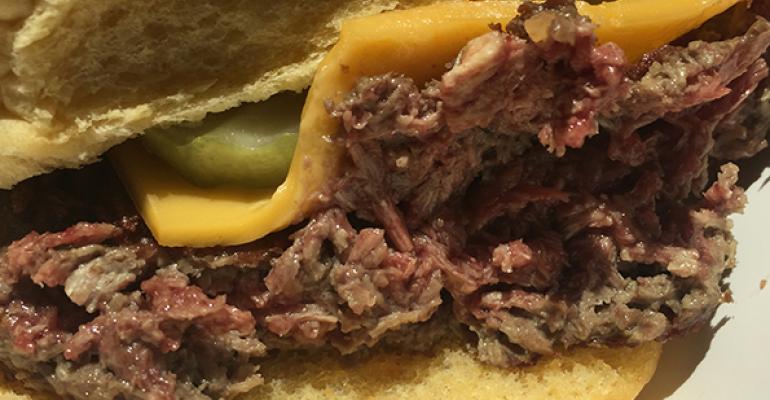 This post is part of the Food Writer’s Diary blog.
This post is part of the Food Writer’s Diary blog.
Whenever I'm presented with vegetable matter disguised as meat, I wonder why anyone would want to do that. If you want to eat meat, eat meat. If you don't, why not just eat vegetables? Vegetables are delicious, and they're most delicious when you treat them like vegetables.
Ah, Patrick Brown said, but people love meat. They’re not going to stop eating it, and as the middle class expands in the developing world, demand is only going to go up. The problem is that meat is a strain on the environment. Producing it requires much more energy and uses much more water than if we ate vegetables.

So Brown, a medical doctor and scientist, founded Impossible Foods, and developed the Impossible Burger, which he insists tastes and acts like meat, but is made from ordinary vegetable matter — just simple things a chef might have lying around in his or her pantry.
Well, except for heme, a component found in all living cells — plant, fungus, bacteria and animal, he said — but particularly in the red blood cells of animals, where it's responsible for carrying oxygen.
Other than that, the Impossible Burger contains water, wheat protein, potato protein, coconut oil, carbohydrates from a Japanese yam and xanthan gum.
The wheat protein, which Brown said, "is probably the most widely consumed protein in the human diet, and has been for thousands of years” confers "some of the critical chew ... as well as some of the fibrous characteristic that is classic for a burger."

The potato protein "has a quality that forms a gel that at low temperature is squishy, but once you cook it becomes firm, which is an essential feature of the texture of the burger," Brown said. It's also good at retaining water.
The coconut oil provides the fat, which is necessary for the mouthfeel, and so we can taste the fat-soluble flavor components. And the carbohydrates are glycogen, which is an important component in beef flavor, and two polysaccharides that Brown said provide some cohesion to the burger and contribute to its juiciness. Xanthan gum also lends to the moisture retention.
Catalyzing all of those flavors is the heme, which turns those ingredients into the "literally hundreds of volatile compounds that are the unique, unmistakable, craveable flavor" of grilled meat.
Brown said the Impossible Burger has no artificial flavors, and did his best to give the impression that this is a natural product. I kind of feel like calling him out on that, but then I'd have to ask what “natural” means, and I don't really feel like opening that can of worms.
So, how does it taste? Well, superstar chef and restaurateur David Chang likes it enough that he’s is putting it on the menu at his restaurant Nishi starting July 27. It will be topped with romaine lettuce, beefsteak tomato, pickles and an unidentified "special sauce" on a Martin's potato roll with a side of shoestring fries. Cheese is available on request.
It will be priced at $12, which is a good price for a restaurant like Nishi.
Brown said the Impossible Burger is currently priced around what organic meat at Whole Foods would cost, but he said he's confident that over time, as production is ramped up, he can reduce the price to equivalent or below that of standard ground beef.
Let's hope so, because he said about $80 million was spent developing the product.
Nutrition-wise, it has about the same number of calories as regular ground beef, with slightly more protein and slightly less fat.
Environment-wise, Brown said it uses an eighth of the greenhouse gas, a quarter of the water and less than a twentieth of the land area needed to produce ground beef.
OK. But really, how does it taste?
Well, as you can see, it looks pretty hamburger-like. Its mouthfeel is, well, a bit more mushy than most hamburgers, as though it might have been made with a higher-than-normal percentage of lean finely textured beef. But it did have a bit of maillard-reaction browning to it.
However, the overall flavor, to me, was that of toasted grain.
It was actually very tasty, and I could honestly say to Chang, who was at the event to launch the burger, that I enjoyed it.
But I'm afraid that the search for meatless meat that tastes like meat continues.
Contact Bret Thorn at [email protected]
Follow him on Twitter: @foodwriterdiary

